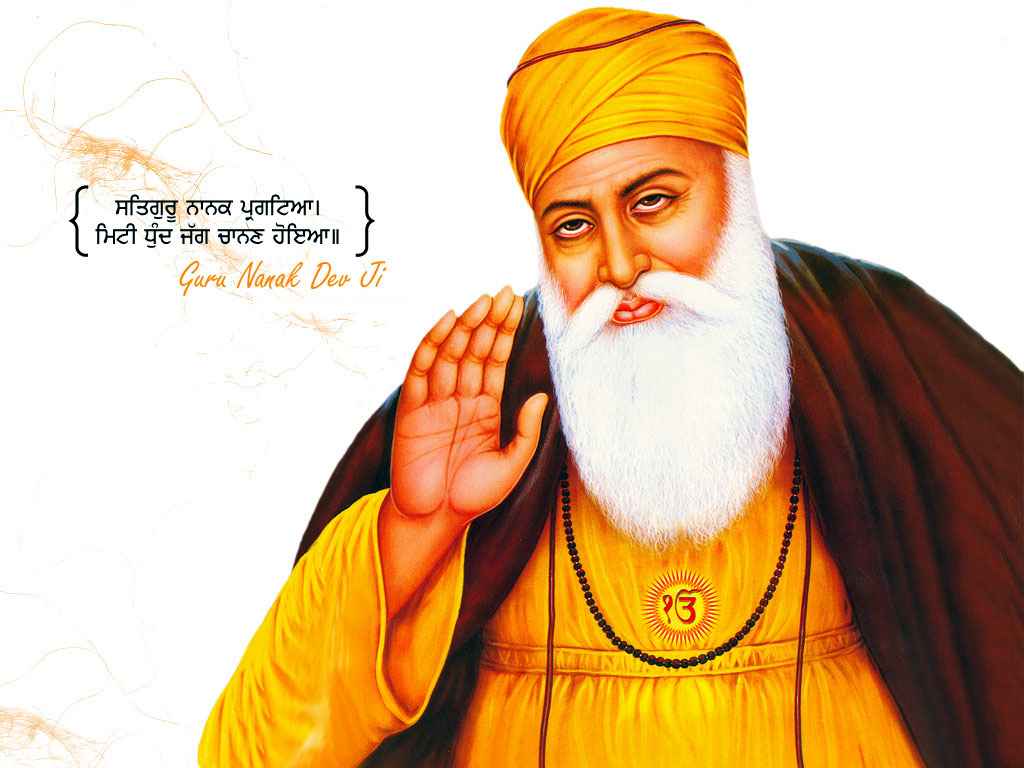Read this article to learn about Guru Nanak and Sikhism in India!
Guru Nanak (1469-1538):
Guru Nanak, from whose teachings the Sikh religion was derived, was born in the village of Talwandi (now called Nankana) in 1469.
Like Kabir, Nanak also preached a casteless, universal, anti-ritualistic, monotheistic and highly spiritual religion.

Image Source: hdwallpapersdownloadz.com/wp-content/uploads/Hindu-God-Guru-Nanak-Dev-Ji-Wallpaper-Free.jpg
ADVERTISEMENTS:
He laid great emphasis on the purity of character and conduct as the first condition of approaching God and the need of a Guru for guidance. His catholic approach aimed at bridging distinctions between the Hindus and the Muslims. Janam-Sakhis are hagiographic narratives of his life. He started free community kitchens called Guru Ka Langar. He died at Kartarpurin 1538.
Teachings of Nanaka:
Nanak had no intention of founding a new religion. He wanted to work only as a bridge between Hindus and Muslims.
He laid emphasis on:
ADVERTISEMENTS:
1. The one God, by repeating whose name and dwelling on it with love and devotion one could get salvation without distinction of caste, creed or sect.
2. The purity of character and conduct as the first condition of approaching God.
3. The need of a guru for guidance.
4. Denouncing idol-worship, pilgrimages and other formal observances of the various faiths.
ADVERTISEMENTS:
5. Advocating a middle path in which spiritual life could be combined with the duties of the householder.
Some other Facts on Sikhism:
1. Guru Nanak nominated Guru Angad as his successor. After Guru Nanak’s death, his followers founded a new religious sect, Sikhism. Guru Angad (1538-52) started the Gurumukhi script. Humayun came to Angad to get his blessings.
2. Guru Amardas (1552-74), the third Guru reformed the institution or langar.
3. Guru Ramdas (1575-81), the fourth Guru, was given the site of Har-Mandir at Amritsar by Akbar.
4. Guru Arjun (1581-1606) compiled the Adi Granth (later called Granth Sahib) and also completed the construction of Har-Mandir at Amritsar. He was executed by Jahangir.
5. Guru Hargobind, (1606-44) titled himself Saccha Padshah and introduced militancy among the Sikhs. He built the Akal Takht.
6. Guru HarRai (1644-61).
7. Guru Har Kishan (1661-64).
8. Guru Tegh Bahadur (1664-75) was executed by Aurangzeb at Delhi.
9. Guru Gobind Singh (1675-1708) the 10th and the last Guru of the Sikhs established the Khalsa in 1699 and organised the Sikhs into a militancy sect. He was stabbed to death in Deccan at Nanded by a Pathan.
Adi Granth:
Adi Granth is the holy religious book of Skhism. It was compiled by Guru Arjun Dev (1581-1606), the 5th Guru of Sikhism. Adi Granth is also known as Guru Granth Sahib.
The Khalsa:
Khalsa was established by the tenth and the last Guru of Sikhism cult, Guru Govind Singh (1675- 1708). By the establishment of Khalsa, Guru Govind Singh organized the Sikhs into a militancy sect. A Sikh is initiated into the religion by a rite known as the pahui (khande ka pahul). The orthodox Sikhs are distinguished by the five-K’s viz., kesa, kachha, kara, kanga and kirpan.
